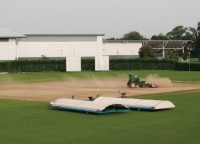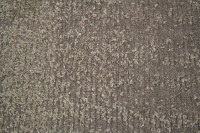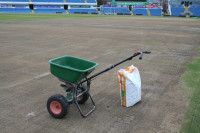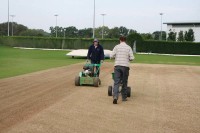October Cricket Diary
 The weather for September has been unusual, with significantly dry periods continuing right throughout the month.This is the time when your irrigation system proves its worth for the majority who are in the midst of end of season renovations, as moisture retention in the soil is vitally important.
The weather for September has been unusual, with significantly dry periods continuing right throughout the month.This is the time when your irrigation system proves its worth for the majority who are in the midst of end of season renovations, as moisture retention in the soil is vitally important.
In some parts of the country we are getting air temperatures well up to 18 degrees C, ideal weather conditions for seed germination.
Indeed, many Groundsmen are seeing their seed come up with seven days.
The longer you leave your renovations the less likely you will obtain favourable germination rates. Air temperatures tend to drop in October thus slowing down grass growth. The use of germination sheets will help.
All clubs have their own methods of working and renovating their squares. In most cases the level of work will be dictated by what budgets and resources they have available at the time, and what they are trying to achieve.
In the main most club groundsmen are now putting on between 6-10 bags of loam per wicket. It is important not to under or over-dress your tracks.
 Even in the current economic climate, it is best not to skimp on the amount of loam used. I see too many club tracks that do not perform in terms of pace and bounce. Generally, it is usually a combination of two factors that, when combined, cause problems - not getting rid of enough thatch/debris material during renovations and not putting enough loam down to increase the bulk density of the soil profile.
Even in the current economic climate, it is best not to skimp on the amount of loam used. I see too many club tracks that do not perform in terms of pace and bounce. Generally, it is usually a combination of two factors that, when combined, cause problems - not getting rid of enough thatch/debris material during renovations and not putting enough loam down to increase the bulk density of the soil profile.
However, there is a fine line between too much and too little.
It's important not to overdress the square, as you will not only be wasting the precious loam material but you may also be smothering your sward. The last thing you want to be doing is burying any vegetation, which will lead to future problems.
The object of the renovations is revitalize the top growing zone and restore levels. Scarification is important to remove unwanted vegetation,
but also to produce a key for the new loam material to sit in.
The level of scarification required will be dependent on how much of a thatch layer you have generated throughout the season. This year
has seen periods of heavy rain followed by high temperatures and grass growth has been prolific; thatch content therefore is likely to be on the
high side. The best way to identify how much you have is by taking a core sample.
It will be then a case of going through a vigorous renovation programme, scarifying in at least three directions, finishing in the line of play.
Ensure you clean off all the thatch debris after each pass. The square can then be oversown using a suitable grass seed mixture; do not be
frightened to try out new cultivars. Sowing rates now range between 35-50 grammes per square metre. In essence you are aiming to
establish new grasses into your square.
 Then it's a case of topdressing to restore levels and to intergrate new material into the soil profile and to build up the clay content in your square. Irrigation should follow as soon as possible to assist in the germination of new seed.
Then it's a case of topdressing to restore levels and to intergrate new material into the soil profile and to build up the clay content in your square. Irrigation should follow as soon as possible to assist in the germination of new seed.
The seed should germinate between 7-10 days weather permitting, a germination sheet will aid germination.
Once you have put your square to bed devote some time to the outfield, an area often neglected if not used for any winter sport such as rugby or football. They do not get much attention in the way of aeration, topdressing, overseeding and, in some cases, not even cut through the winter months.
On the square you should look to maintain a cutting height between 12-30mm, and continue to brush off the dew in the mornings to keep the sward in a dry and disease free condition.
 Aeration is also a key operation to help improve the condition of the soil after a season's play. Soil compaction is often the main contributing factor to poor grass growth; the lack of air in the soil profile inhibits many beneficial activities such as soil water movement and retaining Microbial Organisms.
Aeration is also a key operation to help improve the condition of the soil after a season's play. Soil compaction is often the main contributing factor to poor grass growth; the lack of air in the soil profile inhibits many beneficial activities such as soil water movement and retaining Microbial Organisms.
A programme of de-compacting the soil is essential, preferably using a pedestrian powered vertical aerator, to re-introduce some porosity into the profile. Solid tine, hollow coring and linear aeration are a number of methods now being used to aerate soil profiles.
These operations tend to be carried out on a frequency basis depending on the type and size of the tines being used.
Ideally, on the outfields, penetration should be down to a depth around 200mm to promote deeper rooting. Some groundsmen like to carry out a programme of hollow coring which again increases porosity but can also help redistribute/recycle topsoil which, in turn, helps restore levels.
The frequency of aeration activities will often depend on the resources - money, machinery, time - available. In the main you should be looking to aerate throughout the winter period on a monthly basis, weather and soil conditions permitting.
However, there are a number of groundsmen who never aerate their cricket squares, they believe that the aeration holes formed can cause a weakness/stress line in the clay profile that could eventually break, causing problems with the wickets. They believe that the clay's ability to shrink and swell provides the necessary voids to promote root growth. It would be interesting to find out what proportion of groundsmen follow this train of thought.
Mowing of the outfield should be undertaken on a regular basis to maintain height of cut between 20-35mm.
October is usually a good month to carry out any additional ground works, particularly drainage, especially when using heavy pipe laying machinery. Ground conditions are able to sustain the weight and action of these machines without causing too much damage to the turf surface.
Turf disease can be quite prevalent in October when soil moisture levels increase, coupled with the presence of early morning dews. The combination of moist soils and surface moisture on the leaf blade can increase the susceptibility of disease attack.
Regular brushing in the mornings to remove the dew from the playing surfaces will reduce the likelihood of disease outbreak. Many turf grass diseases can be active at this time of the year - fairy rings, red thread and fusarium are the most commonly seen.
Worms can also be active this month. Keep an eye the square and treat accordingly. Worm treatments can be carried out if needed, but please remember to ask yourself why worms are present. Ph level, organic matter and your cultural practices on the square may need to be assessed. Carbendazim is now the only active ingredient available for controlling worms.
Fertiliser treatment and turf tonics can be continued in accordance with your annual programme. If you haven't got a fertiliser programme,have your soil tested; try an independent soil analysis company for an impartial set of results. Most facility managers will be looking to apply their autumn fertilisers in association with their end of season renovations.
Many Groundsmen fence off the cricket square at the end of the season to protect it from pests, (players, rabbits, deer, foxes), vehicles and vandals.
Other tasks involve inspecting and putting away scoreboards, practice nets and covers.
Bob Stretton
Head Groundsman
Massey Ferguson Sports Club.



